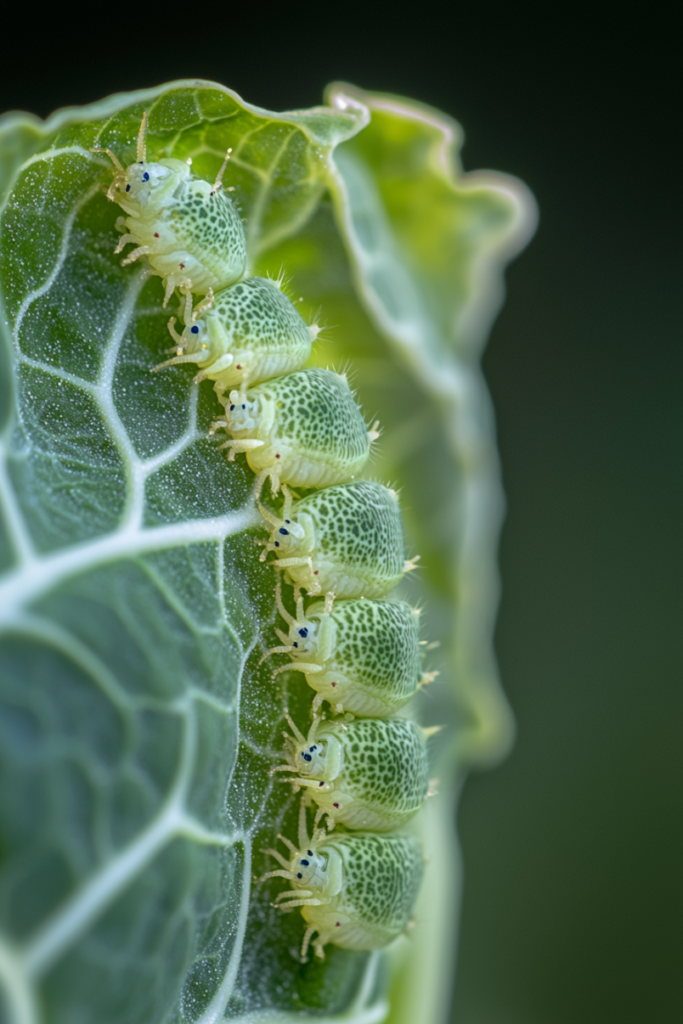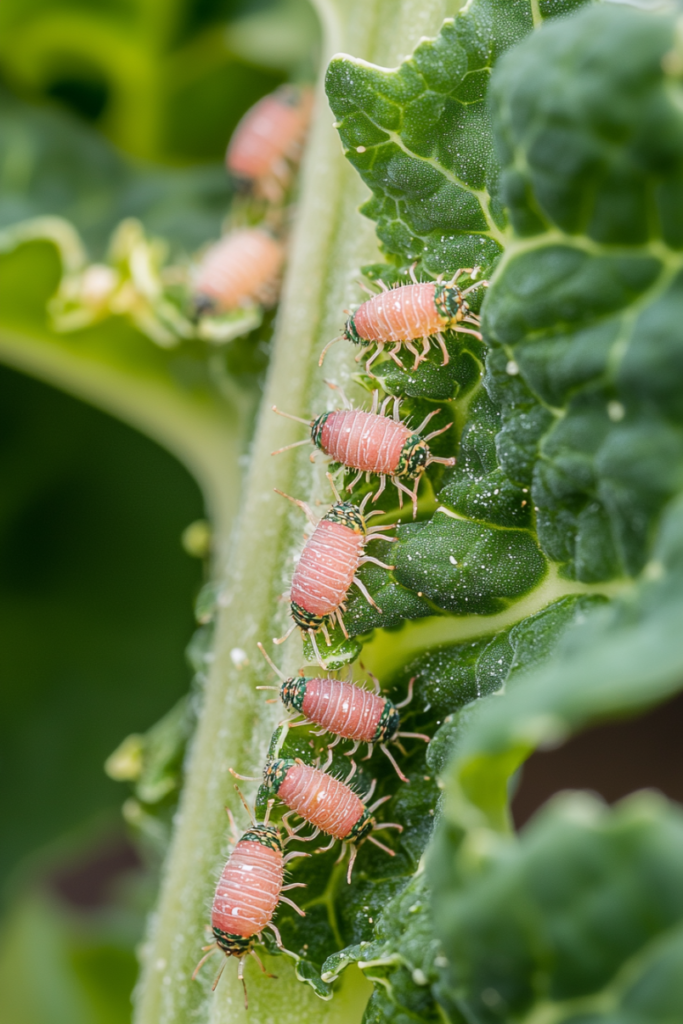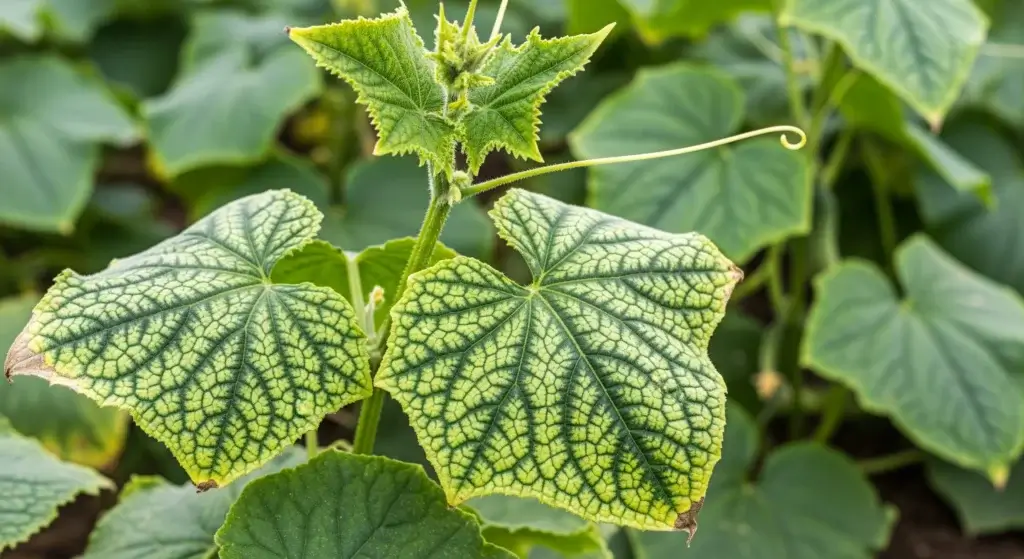
If you’ve ever planted collard greens, you know how frustrating it can be to see holes and chewed-up leaves.
The main culprit? Cabbage worms.
These small pests can cause significant damage to collard greens and other related crops.
They can be multiple generations each season.
The number of generations of cabbage worms that can occur in a year depends on the region’s climate.
This variability highlights the adaptability of cabbage worms to different environmental conditions, allowing multiple cycles of growth and reproduction throughout the year.
What Are Cabbage Worms?
Cabbage worms are the larval stage of certain butterflies and moths, primarily the cabbage white butterfly.
They are green caterpillars with velvety bodies that camouflage well against leafy greens like collards, cabbage, kale, and broccoli.
While they may look harmless, these worms are voracious eaters and can wreak havoc on your crops if left untreated.
One of the most common species is Pieris rapae, also known as the imported cabbageworm.
These pests specifically target plants in the brassica family, which includes collards.
- Read also: Tiny Terror, Big Trouble: Eradicating Cabbage Worms on Your Broccoli
- Read also: How to Identify and Control Cabbage Worms on Brussels Sprouts
Varieties of Cabbage Worms
There are a few different types of cabbage worms, each with its unique characteristics, though they all cause similar damage to crops.
Imported cabbageworm
One of the most common species is Pieris rapae, also known as the imported cabbageworm.
It’s the larva of the cabbage white butterfly, a small white butterfly with black spots.
These worms are green with a light-yellow stripe running down their backs.
These caterpillars are highly destructive, feeding extensively on the inner portions of cabbage heads and producing wet green frass (droppings).
Cabbage looper
Trichoplusia ni or Cabbage looper has a unique inchworm-like movement.
The larvae are light green with pale white stripes along each side and two thin white stripes down their backs.
Unlike the cabbageworm, it comes from the cabbage looper moth.
Besides brassicas, they also infest tomatoes, cucumbers, potatoes, lettuce, spinach, celery, parsley, beets, peas, and other vegetables.
Diamondback moth larvae
These small, slender, and green caterpillars come from the diamondback moth.
They have the scientific name Plutella xylostella.
The larvae are smooth and solid green in color. When disturbed, they thrash and drop off the plant which can be particularly problematic for leafy greens.
Despite their small size, diamondback moth larvae can be extremely destructive to crops, leading to extensive feeding injuries.

Damage to Crops
Cabbage worms can cause significant damage to collards and other brassica plants.
They primarily feed on the leaves, chewing holes that reduce the plant’s ability to photosynthesize.
The feeding also weakens the plant, making it more susceptible to disease.
Here are some signs your collard greens may have a cabbage worm infestation:
- Chewed leaves: Look for irregular holes or missing sections on the leaves.
- Green pellets: These are worm droppings and can often be found on the undersides of leaves.
- Wilted or stunted plants: Severe infestations can cause plants to stop growing or appear unhealthy.
While light feeding may not kill your plants, heavy infestations can lead to significant crop loss, especially in younger plants.
Life Cycle of Cabbage Worms
To better manage cabbage worms, it’s essential to understand their life cycle:
- Egg stage: Adult cabbage white butterflies lay tiny, yellowish eggs on the undersides of leaves. These eggs are often hard to spot due to their size.
- Larval stage: After 5-7 days, the eggs hatch into small green caterpillars, which are the cabbage worms. This stage is the most destructive, as the worms feed on the leaves, leaving behind large holes.
- Pupal stage: Once they’ve eaten enough, the caterpillars spin a chrysalis and enter the pupal stage. This is where they transform into adult butterflies or moths.
- Adult stage: The adult butterflies emerge and begin the cycle again by laying more eggs.
The entire life cycle from egg to adult takes about three to six weeks, depending on the climate.
In warm weather, cabbage worms can multiply quickly, leading to multiple generations in a single growing season.

How to Get Rid of Cabbage Worms
Cabbage worms can be a persistent problem for gardeners, especially when growing crops like collards, kale, and other brassicas.
Luckily, there are several methods to manage and eliminate these pests.
Here are some methods you can use:
Manual removal
One of the easiest and most immediate ways to deal with cabbage worms is by manually removing them from your plants.
Since cabbage worms are green and blend in with the leaves, you’ll need to carefully inspect both the tops and undersides of the leaves.
Check your plants early in the morning or late in the evening when the worms are most active.
Wear gloves if you prefer not to touch them directly.
As you find the worms, pluck them off the plants and drop them into a container filled with soapy water.
The soap prevents them from surviving once they are submerged.
Manual removal doesn’t rely on chemicals, so it’s a great organic method for smaller gardens.
It’s also fast and doesn’t risk harming beneficial insects in your garden.
Neem oil
Neem oil is a popular organic pesticide that has multiple benefits for managing pests like cabbage worms.
Derived from the seeds of the neem tree, it’s safe for humans and animals while being effective at controlling pests.
When sprayed on plants, neem oil disrupts the feeding behavior of cabbage worms, effectively causing them to starve and die.
Additionally, it affects their ability to grow and reproduce, reducing the overall population over time.
Mix the neem oil with water according to the instructions on the bottle, usually 1-2 tablespoons of neem oil per gallon of water.
Spray it generously on the affected plants, focusing on the undersides of the leaves where cabbage worms often hide.
Always spray during the cooler parts of the day—early morning or late afternoon—to avoid burning the leaves.
Reapply every 7-10 days or after heavy rain.
Bacillus thuringiensis (Bt)
Bacillus thuringiensis (Bt) is a naturally occurring bacterium that specifically targets caterpillars like cabbage worms.
This biological control method is widely used in organic farming and is safe for plants, humans, and beneficial insects.
Bt produces a toxin that, when ingested by cabbage worms, disrupts their digestive system.
The worms stop eating and die within a few days.
The great advantage of Bt is that it only affects caterpillars, leaving beneficial insects like bees, ladybugs, and earthworms unharmed.
Bt is available in powder or liquid form.
For liquids, mix it according to the product instructions (usually 1-2 teaspoons per gallon of water) and spray it directly on the leaves of your plants, especially the undersides where cabbage worms tend to hide.
Reapply every 7-10 days or after rain.
Since Bt degrades in sunlight, apply it early in the morning or late in the evening for the best results.

Floating row covers
Floating row covers are one of the best preventive measures you can use to stop cabbage worms from invading your garden.
These lightweight fabrics act as a physical barrier.
Keeping pests like cabbage butterflies from laying eggs on your plants.
Cover your plants with floating row covers immediately after planting or transplanting.
Ensure the edges are securely fastened to the ground so that no insects can sneak in from underneath.
Floating row covers still allow sunlight, water, and air to reach your plants, so they won’t affect their growth.
Once your plants begin to flower, you may need to temporarily remove the row covers to allow for pollination, especially if you’re growing plants that need pollinators.
Encourage natural predators
Encouraging natural predators in your garden can be one of the most effective and eco-friendly ways to control cabbage worms.
Predators like birds, parasitic wasps, and predatory beetles will naturally help to keep cabbage worm populations in check.
How to attract them:
- Birds: Install bird feeders or birdbaths near your garden to attract insect-eating birds like wrens and finches.
- Parasitic wasps: Plant flowers like marigolds, yarrow, and dill to attract parasitic wasps. These wasps lay their eggs inside cabbage worms, killing the worms as the wasp larvae grow.
- Predatory beetles: Mulch your garden beds to create a habitat for ground beetles, which feed on cabbage worms and other pests.
Encouraging natural predators creates a balanced ecosystem in your garden.
Unlike chemical controls, this method is sustainable and doesn’t require constant intervention.
Crop rotation
Crop rotation is a powerful technique for preventing cabbage worms from becoming a recurring problem in your garden.
By rotating crops, you break the life cycle of pests that may have laid eggs or pupae in the soil.
Avoid planting brassicas (like collards, cabbage, broccoli) in the same area of your garden year after year.
Instead, rotate them with non-host crops like tomatoes, beans, or carrots.
This denies cabbage worms a continuous food source and makes it harder for them to establish a presence.
In addition to crop rotation, consider adding cover crops or mulch during the off-season to further disrupt pest life cycles.

- Read also: The Pesticide Paradox: The Impact of Pesticides on Vegetable
- Read also: Pest Damage on Vegetables: A Guide to Identification and Control
Conclusion
Cabbage worms are a common problem for gardeners growing collards and other brassicas.
While these pests can cause significant damage, they can be effectively managed with a combination of natural methods and vigilance.
From manually removing the worms to using organic pesticides like neem oil and Bt, there are many ways to protect your crops and keep your garden healthy.
By taking action early, you can minimize the damage they cause and enjoy a bountiful harvest of collard greens.
FAQs
Cabbage worms primarily target brassica plants like collards, cabbage, kale, and broccoli. They are unlikely to infest other types of plants outside this family.
Yes, it’s safe to eat collard greens with holes caused by cabbage worms. Just wash the leaves thoroughly to remove any worms or droppings before cooking or consuming.
Cabbage worms cannot survive freezing temperatures, so they die off in winter. However, eggs and pupae may overwinter in the soil, so crop rotation is essential to break their life cycle.



